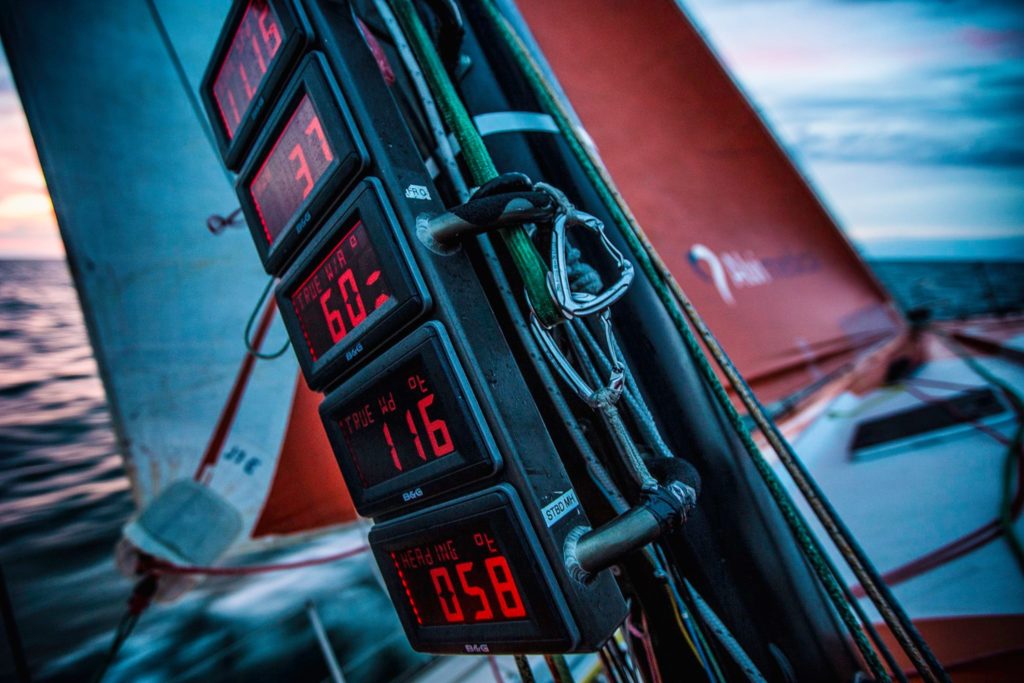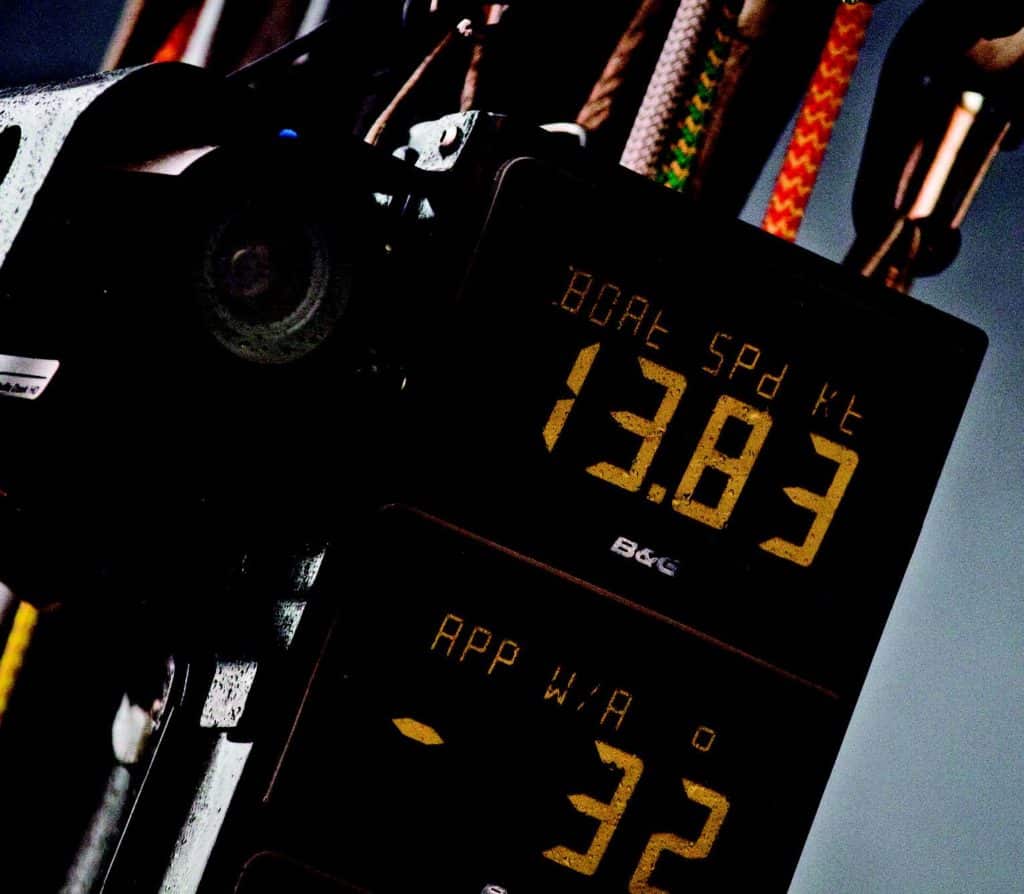
One challenge we all share is sailing the boat at its most efficient speed for the conditions. We’re talking target speed: a theoretically perfect number where the forward speed of the boat and the true-wind angle are optimized either into or away from the wind. Designers generate a chart of target speeds and angles for a range of windspeeds, and sailors obsess with trying to keep that number for a given windspeed locked on the speedo. The concept seems easy: sail the boat at whatever wind angle and sail trim gets you to the target speed, which should mean you’re getting to the next mark more efficiently than a competitor struggling to maintain its target. Wind and water conditions change the ease with which we reach our targets, but that’s the fun of using theory in a sport that involves nature. Theory gets you started, but every day on the water is different so adapting is critical.
Sailing to a target speed is more than matching a boatspeed to a windspeed. For a given “perfect” theoretical speed, you simply can’t ignore heel angle, wind angle, fore and aft trim, sail trim, mast rake, rudder angle, and so forth. Any one of these being out of balance can affect the rest of the equation. Part of the skill of sailing your boat well is learning how to adjust your setup for the conditions to be as close to that perfect number as you can be. First of all, windspeed may be markedly different at the top and bottom of your sails. Waves or choppy conditions also make it difficult to maintain a constant speed. Puffy conditions can cause you to be too fast against the target, then too slow, as the breeze fills and recedes. All of these dynamics, of course, make using the science of target speeds somewhat of an art form.
So let’s agree targets are in fact “moving,” depending on conditions. What’s the best way to use them? First, as with anything computed, you need quality input. Your compass must be accurate and reliable. Your speedo needs to be correctly calibrated. Then you must carefully calibrate your instruments so you’re seeing similar wind angles tack-to-tack, and similar true windspeeds upwind and downwind. If calibration is outside your skill set, enlist an expert to get everything set up right. The wind gear/compass/boatspeed relationship is vital for getting value out of your target chart.
Once you’re confident in your instrument calibration you can check in against the theoretical upwind and downwind targets. These usually come from the boat’s designer, and then they’re massaged by experience and real-world adaptation. A laminated printout may be all you need. Tape it to the companionway and use it as a guide to get a feel for what speeds you should sail based on windspeed, wind angle, and sea state. I find most inexperienced sailors tend to sail their boat too slowly (pinching), and many experienced teams go a bit too fast (pressing). Both habits inhibit your efficiency. Be careful not to live and die by the numbers, though. They are just as they’re named: targets.
Starting with upwind, let’s talk about using target speed to learn your boat. Suppose your target speed for 12 knots of windspeed is 6.7 knots. If you trim your sails and head upwind with the team hiking and everything feeling good, you should be able to get to your target number easily. The next step is to experiment with trimming the sails a little harder, maybe get the team to hike more aggressively and point a little higher while preserving your speed. It will be more difficult to consistently hold the target, but you can probably do so with greater concentration.
Any gain you make by pointing higher without sacrificing speed becomes a real bonus on race day. Using the target number to continually check in keeps you confident that you’re going well, even without another boat next to you to gauge against. Every time you’re near another similar boat, be sure to check that the target speed you’re sailing to is a good one. There are times when you will need to mentally adjust that speed up or down, and measuring against other boats is the most accurate means to confirm your adjustments.
When you hit a wave or sail into a lull, you’ll have to bear away slightly to try to recover your speed. It may take a few seconds before the speedo climbs back to that target number, even though you have more heel, more rudder angle, and the boat feels as if it has more power. That’s because you’ve lost your equilibrium and you have to make adjustments to let the boat go forward again.
Usually, all it takes to reestablish momentum is an ease of the mainsheet. If you need more, drop the traveler down a few inches. If you still can’t get to your target, ease the jib. Eventually, you’ll see the speed climb and you’ll be back at target. Once you’re there, you can trim in both sails again. It’s a continuous loop of squeezing the most height and speed from your boat, finding the edge, and easing sails to get the boat going forward again. Like a glider pilot riding the updrafts, you need enough speed to make the foils work well, but you also need to ask the boat to climb to make it upwind faster than the fleet.

Targets
It’s the same concept downwind. Speeds will fluctuate more with puffs, waves and sailing-angle changes, requiring trimmers to be more active than they would be upwind. But the concept still applies: If you sail too high and fast, you’re giving away distance to the next mark. If you’re too low and slow, you’re taking longer to get there. Knowing your targets will help you hone in on the best mode for the day, depending on the conditions, as will keeping a keen eye on similar boats, which will to tell how you’re going.
Nail the numbers
Straight-line sailing to target speed is an important skill, but one of the greatest gains you can make in a close fleet is to be more efficient through your turns. Each time you tack, jibe, or turn at a mark, the crew should be focused on getting the boat back to target speed. Knowing the number you’re aiming for and working together to trim the sails, roll, and hike the boat. Easing and then slowly increasing tension on the backstay, can make a difference to efficiently getting to speed. Losing a quarter of a boatlength less than your opponent in each tack means one length gained in a four-tack beat.
Another example is rounding the weather mark. Imagine you’re approaching, slightly overstood, in 10 knots of breeze. Your boatspeed is likely .3 to .5 knots over your upwind target. Your downwind target is likely similar to your upwind target in this windspeed. As you bear away, you’ll accelerate before reaching a downwind angle that needs the spinnaker or gennaker to maintain good speed. At that point, the boat will slow until the kite is flying. If the driver makes a smooth turn and the team hoists the downwind sail efficiently, you can fill the sail at a deep angle, before the speed has dipped below target. Then you head up slightly to sail your downwind course. Anyone who keeps reaching at the top mark may be faster, but they’re giving up lots of ground to the team that uses their momentum to get down the course. As long as you’re above the downwind target, sailing deep, below the target wind angle, should result in a gain.
Wallying: high and low modes
“Wallying” is the practice of sailing faster to the next shift, giving up slight VMG gains for the promise of greater leverage when the shift comes. Using target speed to get more out of shifts is an advanced subject, but lets cover the basics.
Upwind, if you know you’re on a lift and expect the wind to head you before layline, you can gain by sailing faster and lower toward the next shift. When the shift comes, the advantage to you will be greater than if you had sailed your normal, target-speed course. The trick is to know how much faster to go. For most boats and most shifts, something between .1 and .3 of a knot above target speed is best. The worst thing you can do is pinch to the next header.
Alternatively, there are times when your tactics require you to work the boat higher than normal, so learning your boat’s high mode is something to practice by squeezing a little more height out of the boat and learning where the speed crashes. For most boats, you can sail .2 to .4 of a knot slower to get a little better height before the mode gets too difficult to maintain and the speed crashes.
Wallying works downwind, too. When you’re sailing a header, but you’re sure you’ll get lifted before the layline, sailing slightly above target gets you to the new shift more quickly and you can use this leverage as a gain. As with a high mode upwind, a low mode is a good downwind tool. Use your target speed to see how low you can sail before the speed crashes.









